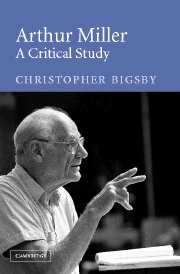Book contents
- Frontmatter
- Contents
- Acknowledgements
- Note on the text
- Introduction
- 1 The Michigan plays
- 2 The Golden Years, The Half-Bridge, Boro Hall Nocturne
- 3 The radio plays
- 4 The Man Who Had All the Luck
- 5 Focus
- 6 All My Sons
- 7 Death of a Salesman
- 8 Arthur Miller: time-traveller
- 9 An Enemy of the People
- 10 The Crucible
- 11 A Memory of Two Mondays
- 12 A View from the Bridge
- 13 Tragedy
- 14 The Misfits
- 15 After the Fall
- 16 Incident at Vichy
- 17 The Price
- 18 The Creation of the World and Other Business
- 19 The Archbishop's Ceiling
- 20 Playing for Time
- 21 The shearing point
- 22 The American Clock
- 23 The one-act plays: Two-Way Mirror, and Danger: Memory!
- 24 The Ride Down Mount Morgan
- 25 The Last Yankee
- 26 Broken Glass
- 27 Mr Peters' Connections
- 28 Resurrection Blues
- 29 Finishing the Picture
- 30 Fiction
- 31 Arthur Miller as a Jewish writer
- Notes
- Index
12 - A View from the Bridge
Published online by Cambridge University Press: 16 November 2009
- Frontmatter
- Contents
- Acknowledgements
- Note on the text
- Introduction
- 1 The Michigan plays
- 2 The Golden Years, The Half-Bridge, Boro Hall Nocturne
- 3 The radio plays
- 4 The Man Who Had All the Luck
- 5 Focus
- 6 All My Sons
- 7 Death of a Salesman
- 8 Arthur Miller: time-traveller
- 9 An Enemy of the People
- 10 The Crucible
- 11 A Memory of Two Mondays
- 12 A View from the Bridge
- 13 Tragedy
- 14 The Misfits
- 15 After the Fall
- 16 Incident at Vichy
- 17 The Price
- 18 The Creation of the World and Other Business
- 19 The Archbishop's Ceiling
- 20 Playing for Time
- 21 The shearing point
- 22 The American Clock
- 23 The one-act plays: Two-Way Mirror, and Danger: Memory!
- 24 The Ride Down Mount Morgan
- 25 The Last Yankee
- 26 Broken Glass
- 27 Mr Peters' Connections
- 28 Resurrection Blues
- 29 Finishing the Picture
- 30 Fiction
- 31 Arthur Miller as a Jewish writer
- Notes
- Index
Summary
A View from the Bridge concerns a longshoreman living in an Italian community in Red Hook, an area adjoining Brooklyn Heights, Miller's home for many years. It was a world he knew. Eddie's is, as Miller has said, a dangerous occupation and it has bred a certain masculine bravado. Passion is a language, a way of life. It is what has consolidated this community and what has the power to break it apart. The longshoremen's union has been infiltrated by organised crime, which effectively controls hiring and firing and protects illegal immigrants, of whom there are many, taking a percentage of their wages. In other words, this is not a world in which the law prevails. It is a community governed by codes and one in which one's masculinity is an essential component of one's work. It is these codes, and this masculinity, that provide the axes against which Eddie plots his life.
Conventionally religious, with no ambition to do more than get by from day to day and be respected by his family and workmates, Eddie agrees to provide refuge for his wife's two cousins, Marco and Rudolpho, illegal immigrants from Italy. Having, in his own eyes, succeeded in realising the American dream himself, he understands what drives them and takes pride in allowing them in his home. When we enter the play, however, there is already a tension that as yet owes nothing to the strangers who are about to disturb his apparent equanimity.
- Type
- Chapter
- Information
- Arthur MillerA Critical Study, pp. 178 - 197Publisher: Cambridge University PressPrint publication year: 2004



